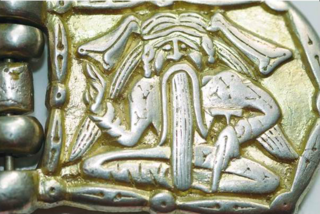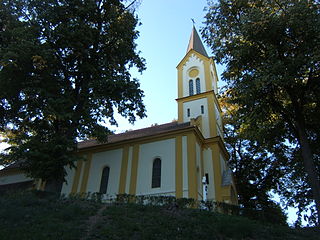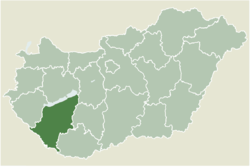
Demographic features of the population of Hungary include population density, ethnicity, education level, health of the populace, economic status, religious affiliations and other aspects.

Hungarian, or Magyar, is a Uralic language of the Ugric branch spoken in Hungary and parts of several neighboring countries. It is the official language of Hungary and one of the 24 official languages of the European Union. Outside Hungary, it is also spoken by Hungarian communities in southern Slovakia, western Ukraine (Transcarpathia), central and western Romania (Transylvania), northern Serbia (Vojvodina), northern Croatia, northeastern Slovenia (Prekmurje), and eastern Austria (Burgenland).

A maypole is a tall wooden pole erected as a part of various European folk festivals, around which a maypole dance often takes place.

Pécs is the fifth largest city in Hungary, on the slopes of the Mecsek mountains in the country's southwest, close to the border with Croatia. It is the administrative and economic centre of Baranya County, and the seat of the Roman Catholic Diocese of Pécs.

A rotunda is any roofed building with a circular ground plan, and sometimes covered by a dome. It may also refer to a round room within a building. The Pantheon in Rome is perhaps the most famous, and is the most influential rotunda. A band rotunda is a circular bandstand, usually with a dome.

Tiszaújváros is an industrial town in Borsod-Abaúj-Zemplén county, Northern Hungary, 35 km (22 mi) south-east of Miskolc, near the river Tisza.

Bardejov is a town in North-Eastern Slovakia. It is situated in the Šariš region on a floodplain terrace of the Topľa River, in the hills of the Beskyd Mountains. It exhibits numerous cultural monuments in its completely intact medieval town center. The town is one of UNESCO's World Heritage Sites and currently maintains a population of about 32,000 inhabitants.

Kapuvár is a small but ancient town of some 11,000 inhabitants in Győr-Moson-Sopron county, Hungary. The town is known for its thermal water which some believe has hydrotherapeutic properties. It is served by highway 85, and has a train station. It borders the Fertő-Hanság National Park, 15 kilometres from the border station of Pomogy. The settlement was fortified as early as the 11th century and was the estate owned by the Nádasdy family in the 16th century. St. Ann's church contains an ancient cemetery that is still being used. Local gastronomic specialties include "clasp-knife platter of Kapuvár," rolled meat of Hany Istók, slaughterman liver, foreleg ham of Kapuvár, rolled meat of Hanság, fritter-like pastry, rolled crêpes filled with preserves, and "pretzel of Rábaköz." There is one fine-dining restaurant in the village, and a few small cafes. A pleasant collection of small, pretty houses with colorful flower gardens reflects the tranquillity of the surrounding rural area. The village was left largely untouched by Russian influences.

Bocfölde is a village in Western Hungary. It has a growing commuter community that works in Zalaegerszeg, the county seat and regional industrial center that is located about 6 km (4 mi) to the North.

Hungarian mythology includes the myths, legends, folk tales, fairy tales and gods of the Hungarians.

Újszentiván is a village in Csongrád county, in the Southern Great Plain region of southern Hungary. Its residents are majority Hungarians, with a minority of Serbs.

Baktakék is a village in Borsod-Abaúj-Zemplén county, Hungary.

Hetes is a village in Somogy county, Hungary.

Kercseliget is a village in Somogy County, southern Hungary.

Patosfa is a village in Somogy county, Hungary.

Somogyegres is a village in Tab District, Somogy county, Hungary.

Gadács is a village in Somogy county, Hungary.

Al-Sawafir al-Sharqiyya was a Palestinian Arab village in the Gaza Subdistrict. It was depopulated during the 1948 War on May 18, 1948, as part of the second stage of Operation Barak. The village was located 32 km northeast of Gaza. It is one of three namesake villages, alongside Al-Sawafir al-Gharbiyya and Al-Sawafir al-Shamaliyya.

The fig is the edible fruit of Ficus carica, a species of small tree in the flowering plant family Moraceae, native to the Mediterranean region, together with western and southern Asia. It has been cultivated since ancient times and is now widely grown throughout the world. Ficus carica is the type species of the genus Ficus, containing over 800 tropical and subtropical plant species.

Palm Tree is a town coterminous with the village of Kiryas Joel, inhabited by the Satmar Hasidic community, and the municipality to which it belonged, Monroe. The population of Palm Tree was 32,954 at the 2020 census.























